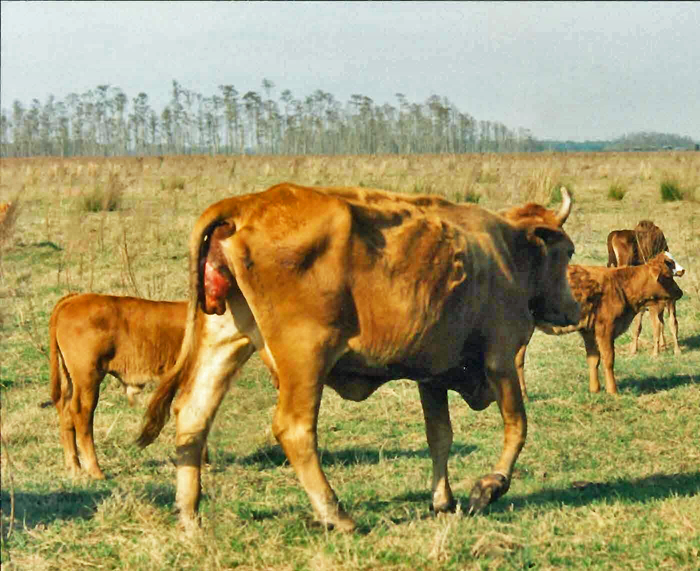
Prolapses occur occasionally in beef cows near calving time. Uterine prolapses are most likely to occur at or shortly after calving, whereas vaginal prolapses occur before the calving process begins. Photo credit: Doug Mayo
Glenn Selk, Oklahoma State University Emeritus Extension Animal Scientist
Prolapses occur occasionally in beef cows. Most prolapses occur around calving time. Two distinct kinds of prolapse exist. Uterine prolapses are most likely to occur during or shortly after calving, whereas vaginal prolapses occur before the calving process begins.
Uterine prolapse require immediate attention and treatment. If corrective action can be taken before major trauma, most animals will have an uneventful recovery. If they subsequently rebreed and become pregnant there is no reason to cull animals suffering uterine prolapse after calving. Uterine prolapse is not likely to reoccur. Some, however, may suffer uterine damage or infection that prevents conception and should therefore be culled. If the uterus becomes badly traumatized before treating, the animal will die from shock or hemorrhage.
Vaginal prolapse, however, that which occurs before calving is a heritable trait and is likely to reoccur each year during late pregnancy. Such animals should not be kept in the herd. The condition will eventually result in the loss of cow, calf, or both plus her female offspring would be predisposed to vaginal prolapse. Call your local large animal veterinarian for proper treatment, or advice about culling of any beef female that has been found to have a prolapse.
Research (Patterson, et al, 1981) from the USDA station at Miles City, Montana, reported that 153 calvings of 13,296 calvings from a 14-year span were associated with prolapse of the reproductive tract. Of those 153 prolapses, 124 (81%) were vaginal prolapses and 29 (19%) were uterine prolapses. The subsequent pregnancy rate following prolapse among first calf heifers was 28% and the pregnancy rate among adult cows following a prolapsed was only 57.9%.
Read more about Calving Time Management for Beef Cows and Heifers by downloading Oklahoma State University Extension Circular E-1006.
- Cotton Marketing News:Acreage Numbers are a Surprise – What Now? - July 11, 2025
- Gulf Coast Cattlemen’s Conference – August 8 - July 11, 2025
- Cotton Marketing News:USDA June Numbers—Neutral, Not Good but Not Bad - June 20, 2025
